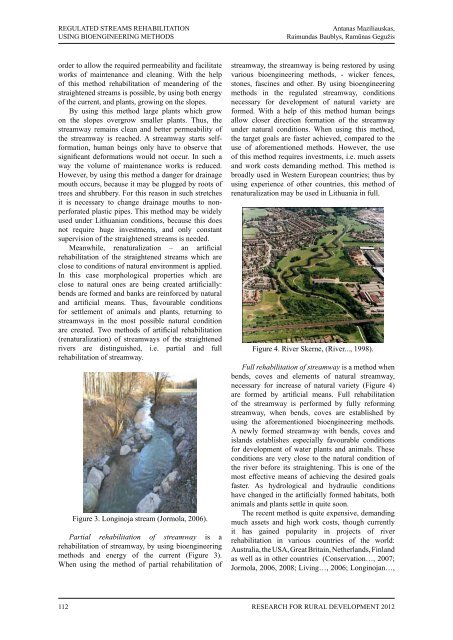RESEARCH FOR
RESEARCH FOR
RESEARCH FOR
Create successful ePaper yourself
Turn your PDF publications into a flip-book with our unique Google optimized e-Paper software.
REGULATED STREAMS REHABILITATION<br />
USING BIOENGINEERING METHODS<br />
order to allow the required permeability and facilitate<br />
works of maintenance and cleaning. With the help<br />
of this method rehabilitation of meandering of the<br />
straightened streams is possible, by using both energy<br />
of the current, and plants, growing on the slopes.<br />
By using this method large plants which grow<br />
on the slopes overgrow smaller plants. Thus, the<br />
streamway remains clean and better permeability of<br />
the streamway is reached. A streamway starts selfformation,<br />
human beings only have to observe that<br />
significant deformations would not occur. In such a<br />
way the volume of maintenance works is reduced.<br />
However, by using this method a danger for drainage<br />
mouth occurs, because it may be plugged by roots of<br />
trees and shrubbery. For this reason in such stretches<br />
it is necessary to change drainage mouths to nonperforated<br />
plastic pipes. This method may be widely<br />
used under Lithuanian conditions, because this does<br />
not require huge investments, and only constant<br />
supervision of the straightened streams is needed.<br />
Meanwhile, renaturalization – an artificial<br />
rehabilitation of the straightened streams which are<br />
close to conditions of natural environment is applied.<br />
In this case morphological properties which are<br />
close to natural ones are being created artificially:<br />
bends are formed and banks are reinforced by natural<br />
and artificial means. Thus, favourable conditions<br />
for settlement of animals and plants, returning to<br />
streamways in the most possible natural condition<br />
are created. Two methods of artificial rehabilitation<br />
(renaturalization) of streamways of the straightened<br />
rivers are distinguished, i.e. partial and full<br />
rehabilitation of streamway.<br />
Figure 3. Longinoja stream (Jormola, 2006).<br />
Partial rehabilitation of streamway is a<br />
rehabilitation of streamway, by using bioengineering<br />
methods and energy of the current (Figure 3).<br />
When using the method of partial rehabilitation of<br />
Antanas Maziliauskas,<br />
Raimundas Baublys, Ramūnas Gegužis<br />
streamway, the streamway is being restored by using<br />
various bioengineering methods, - wicker fences,<br />
stones, fascines and other. By using bioengineering<br />
methods in the regulated streamway, conditions<br />
necessary for development of natural variety are<br />
formed. With a help of this method human beings<br />
allow closer direction formation of the streamway<br />
under natural conditions. When using this method,<br />
the target goals are faster achieved, compared to the<br />
use of aforementioned methods. However, the use<br />
of this method requires investments, i.e. much assets<br />
and work costs demanding method. This method is<br />
broadly used in Western European countries; thus by<br />
using experience of other countries, this method of<br />
renaturalization may be used in Lithuania in full.<br />
Figure 4. River Skerne, (River..., 1998).<br />
Full rehabilitation of streamway is a method when<br />
bends, coves and elements of natural streamway,<br />
necessary for increase of natural variety (Figure 4)<br />
are formed by artificial means. Full rehabilitation<br />
of the streamway is performed by fully reforming<br />
streamway, when bends, coves are established by<br />
using the aforementioned bioengineering methods.<br />
A newly formed streamway with bends, coves and<br />
islands establishes especially favourable conditions<br />
for development of water plants and animals. These<br />
conditions are very close to the natural condition of<br />
the river before its straightening. This is one of the<br />
most effective means of achieving the desired goals<br />
faster. As hydrological and hydraulic conditions<br />
have changed in the artificially formed habitats, both<br />
animals and plants settle in quite soon.<br />
The recent method is quite expensive, demanding<br />
much assets and high work costs, though currently<br />
it has gained popularity in projects of river<br />
rehabilitation in various countries of the world:<br />
Australia, the USA, Great Britain, Netherlands, Finland<br />
as well as in other countries (Conservation…, 2007;<br />
Jormola, 2006, 2008; Living…, 2006; Longinojan…,<br />
112 ReseaRch foR RuRal Development 2012


